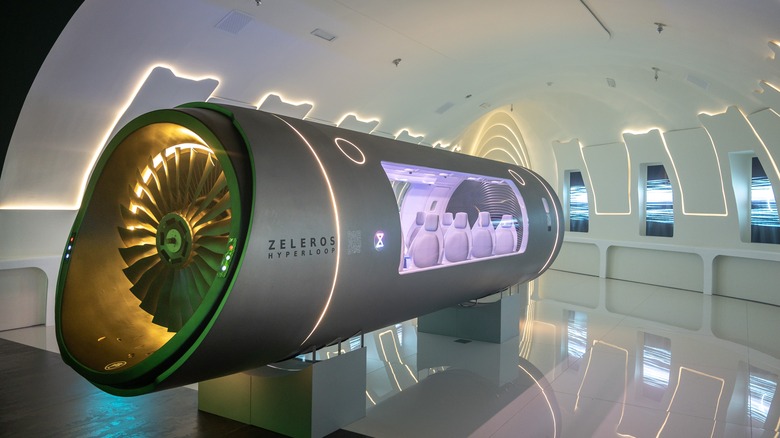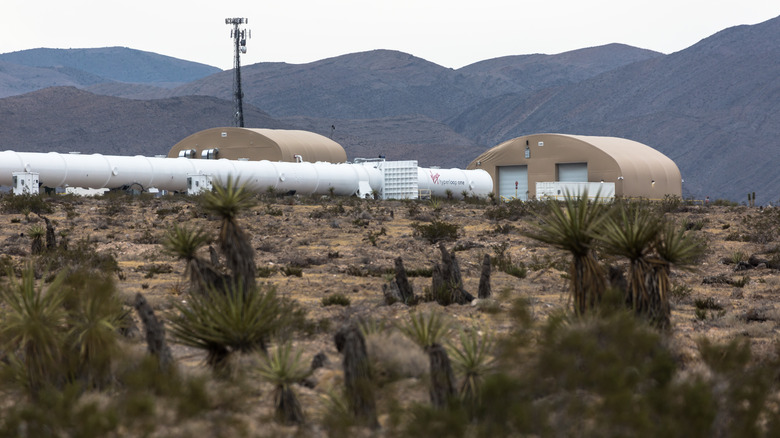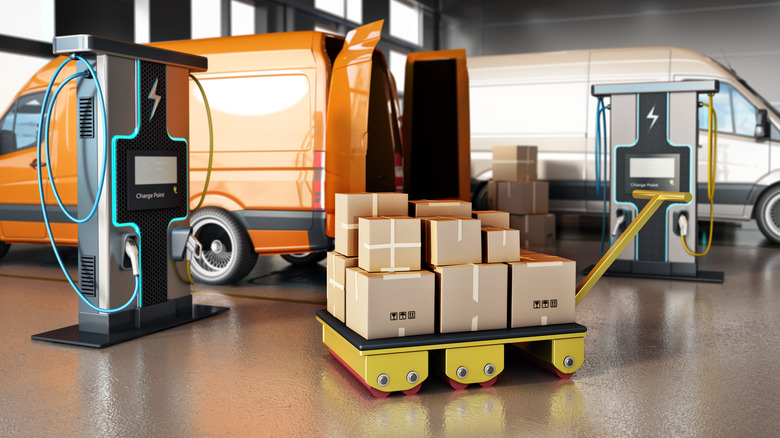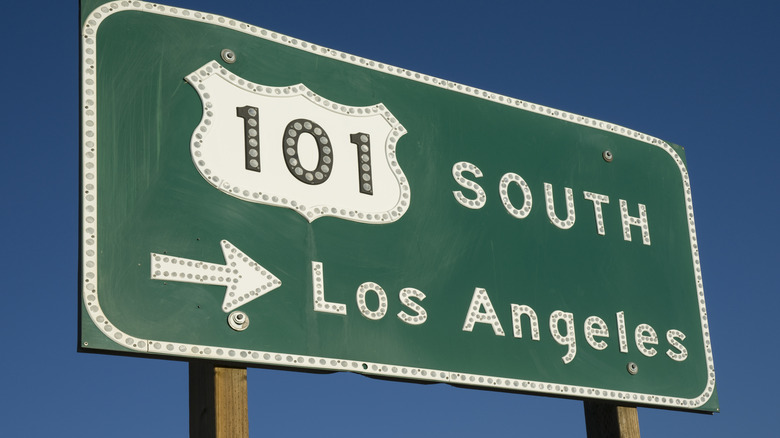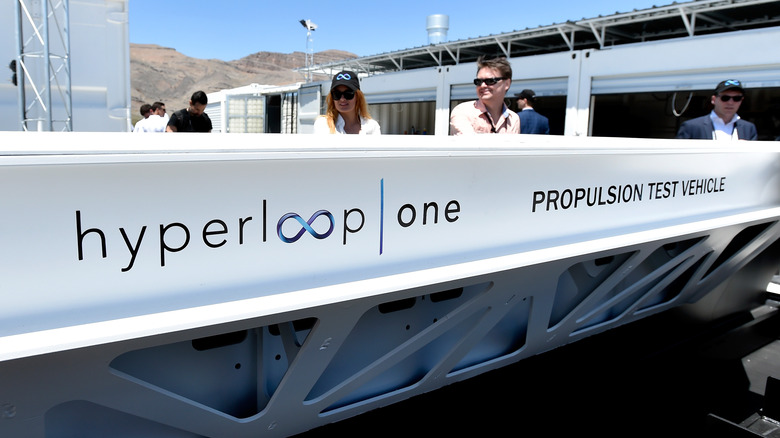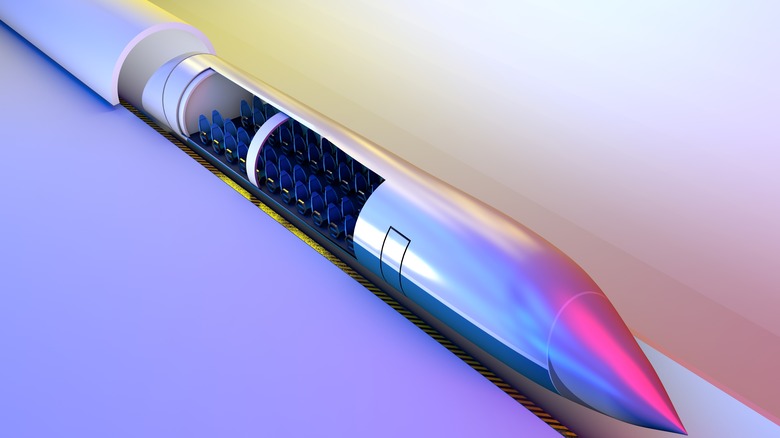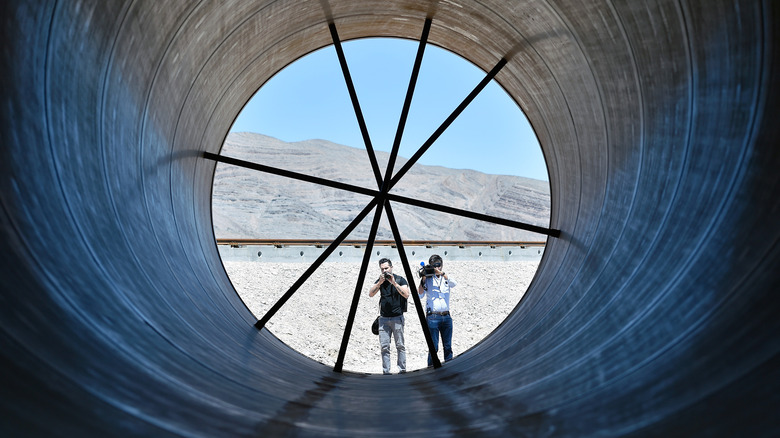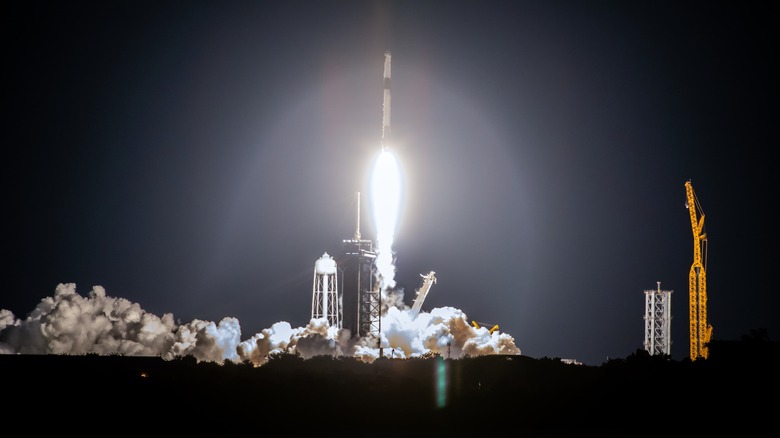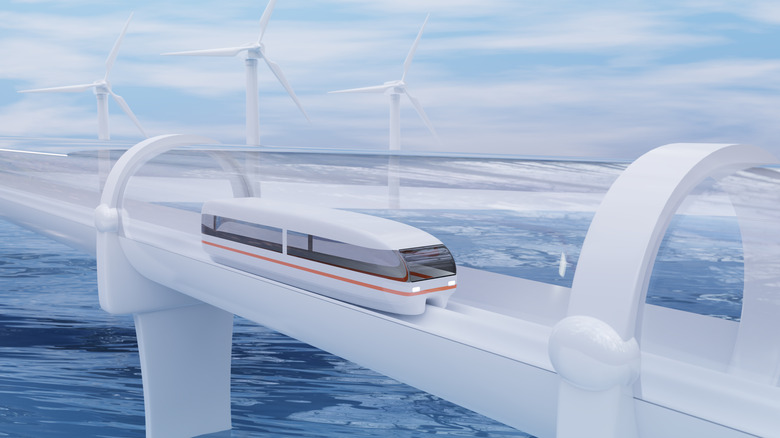Why Is The United States Falling Behind On The Hyperloop?
Elon Musk is very much an ideas man. He regularly comes out with elaborate solutions to the world's problems. His musings have included robotaxis, nuking the Martians, and brain chips capable of giving people a kind of digital telepathy. However, his plans don't always work out. Hyperloop is a prime example of a Musk-backed plan that hasn't really gone anywhere — at least not in North America anyway. When Elon first announced the futuristic, vacuum-tube-based transport system, it promised lightning-quick, eco-friendly, and incredibly affordable travel. And it was supposed to hit America's West Coast first.
Unfortunately, the U.S. seems to be lagging behind China and parts of Europe when it comes to hyperloop. It's high-speed rail all over again. But it doesn't have to be this way. Andrés de León, the CEO of HyperloopTT, spoke exclusively with SlashGear and said he believes the project could take off in the U.S. with the right backing. He also believes it's a more sensible investment than high-speed rail or even roads. Here's a closer look at where the United States may have been going wrong with hyperloop, where other countries stand with it, and what could be done to rectify the problem.
It could solve a lot of infrastructure and environmental issues
On the environmental front, a hyperloop could quite easily be carbon neutral. Musk's original plans involved adding solar panels to the top of the tube, which would charge a large number of batteries and ultimately power the capsule and vacuum pumps. Even without a solar supplement, the U.S. Department of Energy estimates that current electrical infrastructure is enough to power a hyperloop system. Furthermore, the government department also suggests that a hyperloop would in some cases be 20% more energy efficient than the forms of passenger transport we currently use.
Then there's the infrastructure issue. Andrés de León, CEO of HyperloopTT, spoke exclusively to SlashGear and estimated that the public transport solution will be the cheapest option available long-term, beating out the high maintenance costs of roads and coming in cheaper than high-speed rail. When verifying these claims, a lot of factors will play into whether a hyperloop is actually cheaper than laying and maintaining highways. However, there is evidence that it has an advantage over high-speed rail. The pricing for a project intended to connect Stockholm and Helsinki comes in at around $16 million per kilometer cheaper than California's proposed high-speed rail project. While California isn't exactly a cheap place to install infrastructure, Scandinavia has some of the highest infrastructure costs in the world — so the comparison may not be too far out.
It could also revolutionize shipping
A hyperloop is capable of transforming more than just public transport — it could quickly and efficiently move large quantities of goods over vast distances. Again, this would have numerous environmental and societal effects that go far beyond your Amazon Prime parcels arriving slightly earlier. Currently, if you need to move something at high speed, it costs far more and usually involves a plane. A slower, cheaper, method involves trucks, which tend to burn a lot of diesel. Hyperloop could be a clean, cheap way to transport goods between major hubs, with things like trucks taking on the last few miles. This would also make electric trucks a lot more viable.
Because it could be pretty cheap to run, especially when compared to something like a cargo flight, you could also see a reduction in the price of goods overall. Those of you paying attention to inflation figures over the last few years may have noticed a correlation between oil prices and the cost of goods in stores. That's because raw materials have to be transported to manufacturers, and then the goods themselves have to be shipped to a point of sale or your house. You need fuel for every step in this process. Replace some of the longer, more arduous steps with hyperloop and you should see a reasonable reduction in costs. Freight is one of the main areas of hyperloop development, and there's a good chance we'll see hyperloop-based goods transportation systems in many countries before we see hyperloop-based passenger transport.
The first hyperloop could have been in California
In Elon Musk and Tesla's whitepaper, a clear location was laid out for the first potential hyperloop. Connecting the Californian cities of San Francisco and Los Angeles could provide several huge benefits.To start, there are over 48,000 flights between the Bay Area and Greater Los Angeles area per year. Even halving that number would provide some huge environmental benefits, and as the hyperloop is touted as both cheaper and more convenient, the reduction in flights could be greater than that. Then there is the amount of traffic up and down the Pacific Coast Highway and Interstate 5 every day. Again, people could ditch the cars in favor of a cheaper and quicker method of transport.
The population size of the two metropolitan areas also accounts for more than 20 million people combined, and California has strong links to both technological and environmental projects. So on paper, this is the ideal cradle for what might be the future of transportation. So why didn't it happen?
A lot of hyperloop projects have failed
While we've seen a lot of promise on the engineering side of things, the business side may be struggling in some cases. Virgin Hyperloop One, which is closely tied to bearded British billionaire Richard Branson, was leading the way for a long time. It was the first company to actually put humans on a hyperloop and send them for a short ride and had U.S. routes planned out, including one from Kansas City to St Louis. It also conducted the first hyperloop "full systems" test and essentially provided proof of concept for hyperloop. Unfortunately, it no longer exists. Virgin Hyperloop was rebranded as "Hyperloop One" after Branson's exit before announcing it was shifting its focus to freight and finally closing its doors altogether. Hyperloop One also had some pretty hefty financial backing, with the Dubai-based DB World being a major stakeholder. This wasn't enough to save it, and it remains the highest-profile hyperloop failure so far. Numerous other hyperloop startups have also come and gone over the past few years.
Despite these pioneering companies going pop, the groundwork they have laid remains, so other companies may come along and pick up the torch. Many of those companies are state-backed, and that's a reason that the first functioning public hyperloop won't stretch between LA and San Francisco after all.
China may be leading the way
In February 2024, China's hyperloop prototype broke a speed record. According to various news reports, it's currently capable of traveling at 387 miles per hour, and engineers hope to eventually triple that. If they manage, China will have a train that can breeze past the sound barrier and hit speeds that make air travel look a bit sluggish. It's essentially the hyperloop everyone was promised all along.
The train is named the T-Flight and was built by a Chinese state-owned company dubbed the China Aerospace Science and Industry Corporation (CASIC). CASIC's phase two involves extending its test track to 37 miles per hour and hopefully hitting speeds of 621 miles per hour. The initial test track was just 1.2 miles long. Eventual plans for the Chinese hyperloop involve a cross-country high-speed tube running between Beijing and Wuhan that can zip travelers along at up to 1,243 miles per hour. China plans to have its hyperloop in place by 2035, so despite the record it may still be beaten to the punch by projects in other countries. But as far as actual, demonstratable progress goes — the Chinese are currently in the lead.
Europe also has plans for a hyperloop
Although China is leading the way, several European countries are making progress on their own interpretations of the hyperloop. In March 2024, a new European Hyperloop Center opened in the Netherlands. The center includes a quarter-mile tube with a unique and useful feature — a "switch" where the tube parts into two separate sections. This is apparently vital for practical hyperloop implementation should a continent-wide system ever be built.
Marinus van der Meijs, Hardt's technology and engineering director, emphasized to AP News: "Lane switching is very important for hyperloop, because it allows vehicles to travel from any origin to any destination. So it really creates a network effect where you sort of have a highway of tubes and vehicles can take an on and offramp or they can take a lane switch to go to a different part of Europe or to a different destination." The large connected network may be optimistic, as the current goals involve building a short 3-mile stretch of hyperloop by 2030. The center is funded through a combination of government money (provincial, national, and European funds) and private investment.
In Italy, there are solid plans to construct 10 kilometers (6.2 miles) of hyperloop. The short stretch is being built by HyperloopTT — one of the largest and oldest remaining hyperloop companies. The €800 million project aims to be the first functional commercial hyperloop on earth by forging a connection between Venice-Mestre and Padua. A contract was signed back in January 2024, and a short test section is set to be built. This section could then be expanded to connect the two cities along a 40-kilometer stretch — a journey the people behind the project theorize could take around 15 minutes when the hyperloop is built.
Funding seems to be the issue in the US
A lack of investment, and perhaps a lack of enthusiasm for public transport in the political sphere, are the main reasons that the U.S. is lagging behind on hyperloop. HyperloopTT CEO Andrés de León, whose company is based in California, discussed the difficulties in an exclusive talk with SlashGear. Access to Private Participation in Infrastructure (PPI) funding, where private companies chip in on public infrastructure projects, has made a difference in places like Europe. To the CEO, collaboration between private companies seems to be the way forward for U.S.-based projects — especially when it comes to building on the work the California-based company has already done. "For us our next step in the U.S. is to continue with our Great Lakes feasibility study," de León said. "We need funds for that. We need to have companies that can collaborate with us in that process."
Government input doesn't seem to be the issue for de León — the CEO believes the project could be entirely privately funded with the right companies on board. Beyond that, he believes that the U.S. Department of Transportation has been helpful in several ways, but has not been able to "mobilize" federal funds in a way that allows HyperloopTT to continue its research and planning.
Parallels can be drawn with another of Musk's projects
The hyperloop is very Elon Musk — the concept has a lot in common with many of the billionaire's other ideas. On the surface, it's environmentally friendly. It aims to solve a transport-related problem plaguing millions, if not billions, of people. And it's ridiculously ambitious to the point of being arguably unworkable in most places. Some of the hyperloop's biggest champions are also hoping it has a lot in common with SpaceX, or will at least wind up receiving the same amount of government funding and cooperation. Space X has worked with NASA on several projects, with both Musk's company and the government agency ultimately benefiting. Speaking exclusively to SlashGear, HyperloopTT CEO Andrés de León said he's hoping future United States-based hyperloop projects will one day be able to tell a similar story.
"PPI has been a great opportunity, but I think that in the U.S. there are also tools that could be used for these kinds of projects," he said. "SpaceX has contracts with NASA, and I always say the same thing. We don't want grants, we want contracts. For some reason public transport is not being developed in the United States at the same path or the same speed that it's being developed in other parts of the world."
Hyperloop seems to be happening, whether the US is involved or not
While the United States' involvement appears to hang in the balance, hyperloop as a concept is still moving forward. As we've seen, China, Europe, and the Middle East all have an interest in the transport system, and will likely have their own functioning hyperloops by the end of the decade. Looking at other infrastructure projects, the outlook is bleak. High-speed rail is a clear comparison, with many European and Asian nations having extensive systems while the United States has nothing. Plans for a high-speed rail network in the U.S. have been floated since the 1960s but have yet to venture beyond the planning stage. In terms of proposals, the most likely are focused on the state level, and the chances of a national network are currently slim.
Despite progress, hyperloop is still in its infancy, and the United States has plenty of opportunity to catch up and even pull ahead in the race to make the futuristic transport method a reality. The engineering side of things seems settled, and it could solve a lot of the country's problems. Looking at both European and Asian efforts, it does seem like government backing will be needed if an American hyperloop is ever going to exist. While it's easy to be pessimistic about large-scale infrastructure projects getting off the ground in the United States, there is hope when you look at the construction of the interstate highway system in the 1950s, and the current push for EV infrastructure.
